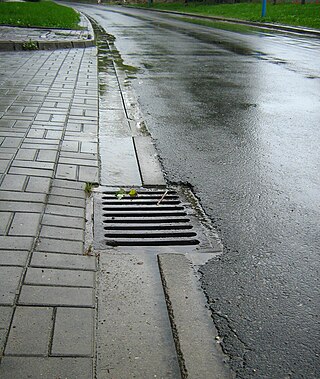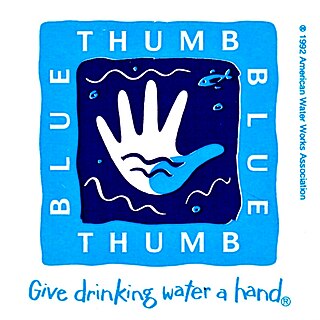
Stormwater, also written storm water, is water that originates from precipitation (storm), including heavy rain and meltwater from hail and snow. Stormwater can soak into the soil (infiltrate) and become groundwater, be stored on depressed land surface in ponds and puddles, evaporate back into the atmosphere, or contribute to surface runoff. Most runoff is conveyed directly as surface water to nearby streams, rivers or other large water bodies without treatment.

Water pollution is the contamination of water bodies, usually as a result of human activities, so that it negatively affects its uses. Water bodies include lakes, rivers, oceans, aquifers, reservoirs and groundwater. Water pollution results when contaminants mix with these water bodies. Contaminants can come from one of four main sources: sewage discharges, industrial activities, agricultural activities, and urban runoff including stormwater. Water pollution is either surface water pollution or groundwater pollution. This form of pollution can lead to many problems, such as the degradation of aquatic ecosystems or spreading water-borne diseases when people use polluted water for drinking or irrigation. Another problem is that water pollution reduces the ecosystem services that the water resource would otherwise provide.

A storm drain, storm sewer, surface water drain/sewer, or stormwater drain is infrastructure designed to drain excess rain and ground water from impervious surfaces such as paved streets, car parks, parking lots, footpaths, sidewalks, and roofs. Storm drains vary in design from small residential dry wells to large municipal systems.

The Clean Water Act (CWA) is the primary federal law in the United States governing water pollution. Its objective is to restore and maintain the chemical, physical, and biological integrity of the nation's waters; recognizing the responsibilities of the states in addressing pollution and providing assistance to states to do so, including funding for publicly owned treatment works for the improvement of wastewater treatment; and maintaining the integrity of wetlands.

Water reclamation is the process of converting municipal wastewater (sewage) or industrial wastewater into water that can be reused for a variety of purposes. Types of reuse include: urban reuse, agricultural reuse (irrigation), environmental reuse, industrial reuse, planned potable reuse, and de facto wastewater reuse. For example, reuse may include irrigation of gardens and agricultural fields or replenishing surface water and groundwater. Reused water may also be directed toward fulfilling certain needs in residences, businesses, and industry, and could even be treated to reach drinking water standards. The injection of reclaimed water into the water supply distribution system is known as direct potable reuse. However, drinking reclaimed water is not a typical practice. Treated municipal wastewater reuse for irrigation is a long-established practice, especially in arid countries. Reusing wastewater as part of sustainable water management allows water to remain as an alternative water source for human activities. This can reduce scarcity and alleviate pressures on groundwater and other natural water bodies.

Biosolids are solid organic matter recovered from a sewage treatment process and used as fertilizer. In the past, it was common for farmers to use animal manure to improve their soil fertility. In the 1920s, the farming community began also to use sewage sludge from local wastewater treatment plants. Scientific research over many years has confirmed that these biosolids contain similar nutrients to those in animal manures. Biosolids that are used as fertilizer in farming are usually treated to help to prevent disease-causing pathogens from spreading to the public. Some sewage sludge can not qualify as biosolids due to persistent, bioaccumulative and toxic chemicals, radionuclides, and heavy metals at levels sufficient to contaminate soil and water when applied to land.

The water industry provides drinking water and wastewater services to residential, commercial, and industrial sectors of the economy. Typically public utilities operate water supply networks. The water industry does not include manufacturers and suppliers of bottled water, which is part of the beverage production and belongs to the food sector.
Sewage disposal regulation and administration describes the governance of sewage treatment and disposal.

A detention basin or retarding basin is an excavated area installed on, or adjacent to, tributaries of rivers, streams, lakes or bays to protect against flooding and, in some cases, downstream erosion by storing water for a limited period of time. These basins are also called dry ponds, holding ponds or dry detention basins if no permanent pool of water exists.

Effluent is wastewater from sewers or industrial outfalls that flows directly into surface waters, either untreated or after being treated at a facility. The term has slightly different meanings in certain contexts, and may contain various pollutants depending on the source.

American Water Works Association (AWWA) is an international non-profit, scientific and educational association founded to improve water quality and supply. Established in 1881, it is a lobbying organization representing a membership of around 50,000 members worldwide.

A combined sewer is a type of gravity sewer with a system of pipes, tunnels, pump stations etc. to transport sewage and urban runoff together to a sewage treatment plant or disposal site. This means that during rain events, the sewage gets diluted, resulting in higher flowrates at the treatment site. Uncontaminated stormwater simply dilutes sewage, but runoff may dissolve or suspend virtually anything it contacts on roofs, streets, and storage yards. As rainfall travels over roofs and the ground, it may pick up various contaminants including soil particles and other sediment, heavy metals, organic compounds, animal waste, and oil and grease. Combined sewers may also receive dry weather drainage from landscape irrigation, construction dewatering, and washing buildings and sidewalks.

An infiltration basin is a form of engineered sump or percolation pond that is used to manage stormwater runoff, prevent flooding and downstream erosion, and improve water quality in an adjacent river, stream, lake or bay. It is essentially a shallow artificial pond that is designed to infiltrate stormwater through permeable soils into the groundwater aquifer. Infiltration basins do not release water except by infiltration, evaporation or emergency overflow during flood conditions.

A percolation trench, also called an infiltration trench, is a type of best management practice (BMP) that is used to manage stormwater runoff, prevent flooding and downstream erosion, and improve water quality in an adjacent river, stream, lake or bay. It is a shallow excavated trench filled with gravel or crushed stone that is designed to infiltrate stormwater though permeable soils into the groundwater aquifer.

The California Building Industry Association is a statewide trade association based in Sacramento representing thousands of member companies including homebuilders, trade contractors, architects, engineers, designers, suppliers and industry professionals in the homebuilding, multi-family and mixed-use development markets. CBIA members build nearly 9 out of 10 new housing units built in California, including charity homes, legally defined as affordable housing, middle-class market-rate housing and luxury homes.

Sewage is a type of wastewater that is produced by a community of people. It is typically transported through a sewer system. Sewage consists of wastewater discharged from residences and from commercial, institutional and public facilities that exist in the locality. Sub-types of sewage are greywater and blackwater. Sewage also contains soaps and detergents. Food waste may be present from dishwashing, and food quantities may be increased where garbage disposal units are used. In regions where toilet paper is used rather than bidets, that paper is also added to the sewage. Sewage contains macro-pollutants and micro-pollutants, and may also incorporate some municipal solid waste and pollutants from industrial wastewater.

Nutrient pollution, a form of water pollution, refers to contamination by excessive inputs of nutrients. It is a primary cause of eutrophication of surface waters, in which excess nutrients, usually nitrogen or phosphorus, stimulate algal growth. Sources of nutrient pollution include surface runoff from farm fields and pastures, discharges from septic tanks and feedlots, and emissions from combustion. Raw sewage is a large contributor to cultural eutrophication since sewage is high in nutrients. Releasing raw sewage into a large water body is referred to as sewage dumping, and still occurs all over the world. Excess reactive nitrogen compounds in the environment are associated with many large-scale environmental concerns. These include eutrophication of surface waters, harmful algal blooms, hypoxia, acid rain, nitrogen saturation in forests, and climate change.

George S. Hawkins is a lawyer, college professor and environmentalist. He served as general manager of the DC Water and Sewer Authority from 2009 to 2017. Hawkins has worked in the environmental industry, as a corporate lawyer and as a regulator.
National Association of Clean Water Agencies (NACWA) represents the interests of publicly owned wastewater treatment facilities, collection systems, and stormwater management agencies before the United States Congress, several Federal agencies, and in the courts. National Association of Clean Water Agencies advocates for federal funding for clean water agencies and for responsible national policies that advance clean water and a healthy environment.
Lutgarde Raskin is a Belgian-American scientist and Professor of Environmental Engineering. She is best known for her studies of microbial ecology in engineered water systems for sewage treatment and drinking water production.
















